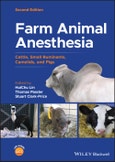A completely revised and updated reference for farm animal anesthesia, sedation, and pain management
The newly revised Second Edition of Farm Animal Anesthesia: Cattle, Small Ruminants, Camelids, and Pigs is a practical and easy-to-use manual for techniques associated with anesthesia and pain management in farm animal species. The new edition incorporates advances in surgical and diagnostic techniques, with the latest drugs and equipment, updated images, and new technique descriptions added throughout the book.
Farm Animal Anesthesia offers additional and updated information on drug combinations and anesthetic techniques relevant to small ruminants and potbellied pigs, reflecting their growing popularity. New chapters and topics on paralytic drugs for complete muscle relaxation, use of ventilators for advanced and complex surgeries, updated local and regional anesthetic techniques, and comprehensive standing surgery and diagnostic procedures have been added.
Readers will also benefit from access to a companion website with video clips demonstrating local and regional anesthetic techniques described within. The book also includes:
- A thorough introduction to general preanesthetic considerations for ruminants, camelids, including alpacas and llamas, and potbellied pigs
- A comprehensive exploration of commonly used preanesthetics and injectable anesthetics, including anticholinergics, sedatives, tranquilizers, analgesics, and injectable anesthetics
- Practical discussions of standing sedation and chemical restraint, including new drug combinations for reliable restraint and remote drug delivery
- In-depth description of the use of neuromuscular blocking drugs and monitoring in farm animals
- Complete review of regulatory and legal considerations of anesthetics and analgesics used in farm animals
Farm Animal Anesthesia is an indispensable resource for farm animal practitioners, veterinary surgeons, veterinary anesthetists, and researchers, as well as for veterinary students and residents in surgery and anesthesia.
Table of Contents
Contributing Authors
Preface
Chapter 1. Preanesthetic Considerations
HuiChu Lin
Positioning
Ruminal tympany
Regurgitation
Salivation
Malignant hyperthermia
Differences in sensitivity to anesthetics
Preanesthetic preparation
References
Chapter 2. Commonly Used Preanesthetics
HuiChu Lin
Acepromazine (phenothiazine derivatives)
Droperidol and azaperone (butyrophenone derivatives)
Detomidine, dexmedetomidine, medetomidine, romifidine, and xylazine (α2 agonists)
Atipamezole, tolazoline, yohimbine, and vatinoxan (α2 antagonists)
Diazepam and midazolam (benzodiazepine derivatives)
Chloral hydrate
References
Chapter 3. Standing Sedation and Chemical Restraint
HuiChu Lin
Cattle
Small ruminants and camelids
Swine
References
Chapter 4. Injectable Anesthetics and Field Anesthesia
HuiChu Lin
Injectable anesthetics
Ketamine
Telazol
Alfaxalone
Guaifenesin
Field anesthesia
Cattle
Small ruminants and camelids
Swine
References
Chapter 5. Neuromuscular Blocking Agents
Stuart Clark-Price
Physiology of the neuromuscular junction
Mechanism of action of NMBA
Depolarizing neuromuscular blocking agents
Non-depolarizing neuromuscular blocking agents
Clinically useful NMBA
Atracurium
Cis-atracurium
Vecuronium
Rocuronium
Monitoring of NMBA action
Reversal of NMBA
References
Chapter 6. Inhalation Anesthesia and Use of Ventilator
HuiChu Lin
Cattle
Small ruminants and camelids
Swine
Use of Ventilators
References
Chapter 7. Perioperative Monitoring and Management of Complications
HuiChu Lin
Perioperative monitoring
Supportive fluid therapy
Positioning
Recovery
Perioperative complications
Regurgitation and aspiration pneumonia
Airway obstruction
Ruminal tympany/bloat
Salivation
Hypoventilation
Cardiac arrhythmias
Hypotension
Hypothermia
Malignant hyperthermia
Postanesthetic neuromyopathy
Cardiovascular collapse
References
Chapter 8. Local and Regional Anesthetic Techniques
Jessica Rush and Jenna Stockler
Local anesthetic agents
Anesthesia for dehorning
Anesthesia for the eye and eyelids
Nasal anesthesia
Anesthesia for reproductive procedures and for cessation of straining
Caudal epidural anesthesia
Continuous caudal epidural anesthesia
Internal pudendal nerve block
Dorsal penile nerve block
Sacral paravertebral nerve block
Lumbosacral epidural anesthesia
Anesthesia for laparotomy
Line block
Inverted L block
Proximal paravertebral block
Distal paravertebral block
Anesthesia for udder and teats
Anesthesia of the limbs
Castration
References
Chapter 9. Anesthetic Management of Specific Procedures
Benjamin Newcomer
Urogenital surgery in the male
Castration
Penile papilloma
Persistent frenulum
Penile translocation
Epididymectomy
Vasectomy
Urogenital surgery in the female
Cesarean section
Ovariectomy
Vaginal prolapse
Perineal laceration
Surgical disorders of the abdomen
Laparotomy
Disorders of the forestomachs
Displacements and volvulus of the abomasum
Small intestine disorders (intussusception, intestinal volvulus, intestinal obstruction)
Urolithiasis and bladder rupture
Umbilical hernias
Musculoskeletal indications
Dehorning
Claw amputation and facilitated ankylosis
Excision of interdigital fibromas
Teeth Floating
Tail docking
Rectal prolapse
Wounds, lumps, bumps, and abscesses
Wound management
Ocular squamous cell carcinoma
Enucleation
Entropion
Abscess removal for caseous lymphadenitis
References
Chapter 10. Pain Management for Farm Animals
HuiChu Lin
Local anesthetics
Systemic pain management
Opioid analgesics
Nonsteroidal anti-inflammatory drugs
Alpha-2 agonists
Ketamine
Gabapentin
Drug combinations for pain management
Constant rate infusion
Local or regional analgesia
Caudal epidural analgesia
Lumbosacral epidural anesthesia
Intra-articular analgesia
References
Chapter 11. Fluid Therapy
Manuel F. Chamorro and Paul H. Walz
General considerations
Physiology of body fluids
Patient assessment
Fluid and electrolyte therapy in the perioperative period
Quantity and rate of fluid administration
Fluid type selection
Fluid therapy in cases of calf diarrhea
Fluid therapy in cases of acute ruminal acidosis (grain overload)
Fluid therapy in cases of Hepatic lipidosis/Ketosis/Pregnancy toxemia
Fluid therapy in cases of abomasal and small intestinal disorders
Fluid therapy for cases of sepsis (septic peritonitis, septic omphalitis, etc.)
Fluid therapy in cases of urinary tract obstruction/rupture
Whole blood transfusions
Method of administration
Monitoring fluid administration
References
Chapter 12. Regulatory and Legal Considerations of Anesthetics and Analgesics Used in Food Producing Animals
Thomas Passler
Alpha-2 agonists and antagonists
Barbiturates
Benzodiazepines
Dissociative anesthetics
Local anesthetics
Opioids
Non-steroidal anti-inflammatory drugs (NSAIDs)
Phenothiazine Derivatives
Propofol
References
13. Euthanasia of Farm Animals
Thomas Passler
Considerations prior to Euthanasia
The Process of Euthanasia
Methods of euthanasia
Injectable euthanasia agents
Physical methods
Adjunctive and other methods of euthanasia
Considerations Subsequent to Euthanasia
References








